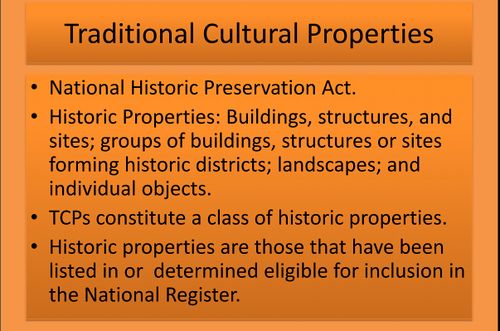Difference between revisions of "Tribal Resources"
Cellsworth (Talk | contribs) |
Cellsworth (Talk | contribs) |
||
| Line 61: | Line 61: | ||
|} | |} | ||
| + | == Tribal Perspectives == | ||
| + | |||
| + | *Taking of life (fish or other) in the Colorado River, with some areas (LCR confluence) being especially sensitive from the tribal perspective. (NPS-CFMPEA_pg 124) | ||
| + | *[[Media:NEPA and Silencing of Native American Worldview Final 01April2013.pdf| NEPA and Silencing of Native American Worldview]]; presentation by Kurt Dongonske to the National Association of Environmental Professionals (2013) | ||
| + | *[[Media:Here and There- The effects of upriver dams on indigenous peoples-Article 3.PDF | Here and There- The effects of upriver dams on indigenous peoples]] by Benedict Colombi (2014) | ||
| + | |||
| + | ---- | ||
| + | |||
| + | <Span>[[File:TCP- Definition- PIC.jpg| TCP|500px]]</Span> | ||
| + | |||
| + | ---- | ||
| + | |||
| + | *[http://www.nps.gov/grca/photosmultimedia/riv-or11.htm NPS Link on Native American Perspectives] and river trip orientation videos | ||
| + | *Land boundary concerns: Some interpretations of federal law hold that the Grand Canyon National Park boundary is at the high water mark of the river. Others hold that it stretches above the rim of the canyon. The issue has never been settled in court. | ||
| + | *Question: Are there some areas along the Colorado River that are considered by the tribes as "off-limits" to non-Indians? Answer: Yes. | ||
| + | *Executive Order 13007 states that a federal agency shall accommodate access to and ceremonial use of Indian sacred sites by Indian religious practitioners and that the federal agency shall avoid adversely affecting the physical integrity of such sacred sites. | ||
| + | |||
| + | ---- | ||
| + | |||
| + | [[Image:TEK- PIC.jpg]] | ||
<!-- | <!-- | ||
| Line 88: | Line 108: | ||
*Zuni Governor Panteah's Letter to Acting Secretary's Designee Regarding Brown Trout removal in Lees Ferry Reach [[File:LtrBrentRheesBrownTroutProblemLeesFerry ZuniGovernorSigned 06February2017.pdf]] | *Zuni Governor Panteah's Letter to Acting Secretary's Designee Regarding Brown Trout removal in Lees Ferry Reach [[File:LtrBrentRheesBrownTroutProblemLeesFerry ZuniGovernorSigned 06February2017.pdf]] | ||
| + | *[[Media:090710 Dissenting Report - TWG FY 2010-11 Work Plan and Budget- Pueblo of Zuni.PDF | Pueblo of Zuni perspective on mechanical removal of non-native fish (2009)]] | ||
|- | |- | ||
Revision as of 18:02, 23 February 2017
|
|
Tribal ResourcesThe lower reaches of Glen Canyon and the river corridor through Grand Canyon National Park, Arizona, have been used by humans for at least 13,000 years. Today, at least nine contemporary Native American Tribes claim traditional cultural ties to this area. Grand Canyon National Park contains more than 4,000 documented prehistoric and historic sites, and about 420 of these sites are located in proximity to the Colorado River. The lower reaches of Glen Canyon contain an additional 55 sites. In addition to archaeological sites, cultural resources along the Colorado River corridor include historic structures and other types of historic properties, as well as biological and physical resources that are of traditional cultural importance to Native American peoples such as springs, unique landforms, mineral deposits, native plant concentrations, and various animal species. Desired Future Condition for Cultural ResourcesPrehistoric Archaeological Sites and Historic Sites: Traditional Cultural Properties (TCPs):
|
| Tribal Ecological Knowledge |
Cultural Resources Library |
Tribal Perspectives |
|---|

